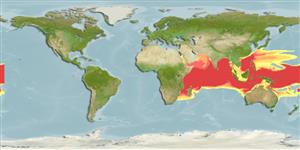Environment: milieu / climate zone / depth range / distribution range
Ecologia
marinhas; estuarina; oceanódromo (Ref. 51243); intervalo de profundidade 0 - 2000 m (Ref. 26165). Subtropical; 25°N - 6°N, 62°E - 100°E
Indian Ocean: confirmed from the Arabian Sea and Bay of Bengal. Reports from outside this area are most likely misidentifications (A.S. Harold, pers. comm., 18/08/98) and name reported from western Pacific may be a misidentification of B. pseudolanceolatus (Ref. 114229).
Tamanho / Peso / Idade
Maturity: Lm ? range ? - ? cm
Max length : 9.6 cm SL macho/indeterminado; (Ref. 4496); common length : 7.0 cm SL macho/indeterminado; (Ref. 2872); peso máx. Publicado: 8.50 g (Ref. 128684)
Descrição breve
Chaves de identificação | Morfologia | Morfometria
Espinhos dorsais (total) : 0; Raios dorsais moles (total) : 57 - 66; Espinhos anais: 0; Raios anais moles: 58 - 69; Vértebras: 52 - 58. Body is elongate, brownish and with speckling above and silvery below. The cheek and lower head also silver. Single occipital ray long and delicate, extending to near the middle of the second dorsal fin (Ref. 46075). Pelvic fins are jugular.
If taxonomy is correct, both onshore in brackish water and oceanic. According to larval survey, occurrence in the tropics is wide (Ref. 9902, 45075). Feed on planktonic crustaceans. Also caught with bagnets (Ref. 2872).
Life cycle and mating behavior
Maturities | Reprodução | Spawnings | Egg(s) | Fecundities | Larvas
Cohen, D.M., 1990. Bregmacerotidae. p. 524-525. In J.C. Quero, J.C. Hureau, C. Karrer, A. Post and L. Saldanha (eds.) Check-list of the fishes of the eastern tropical Atlantic (CLOFETA). JNICT, Lisbon; SEI, Paris; and UNESCO, Paris. Vol. 2. (Ref. 4496)
Categoria na Lista Vermelha da IUCN (Ref. 130435)
Ameaça para o homem
Harmless
Utilização humana
Pescarias: espécies comerciais
Ferramentas
Relatórios especiais
Descarregue XML
Fontes da internet
Estimates based on models
Preferred temperature (Ref.
123201): 5.6 - 13.1, mean 8.8 °C (based on 755 cells).
Phylogenetic diversity index (Ref.
82804): PD
50 = 0.5001 [Uniqueness, from 0.5 = low to 2.0 = high].
Bayesian length-weight: a=0.00372 (0.00152 - 0.00908), b=3.19 (2.97 - 3.41), in cm total length, based on LWR estimates for this (Sub)family-body shape (Ref.
93245).
Nível Trófico (Ref.
69278): 3.3 ±0.42 se; based on food items.
Resiliência (Ref.
120179): Elevada, tempo mínimo de duplicação da população menor que 15 meses (Assuming tm=1).
Fishing Vulnerability (Ref.
59153): Low vulnerability (10 of 100).
Climate Vulnerability (Ref.
125649): Moderate to high vulnerability (48 of 100).
Nutrients (Ref.
124155): Calcium = 371 [67, 1,117] mg/100g; Iron = 2.89 [0.77, 7.08] mg/100g; Protein = 17.3 [14.9, 19.7] %; Omega3 = 0.283 [0.119, 0.635] g/100g; Selenium = 41.6 [13.0, 146.7] μg/100g; VitaminA = 63.1 [14.0, 271.9] μg/100g; Zinc = 1.04 [0.55, 2.50] mg/100g (wet weight); based on
nutrient studies.
